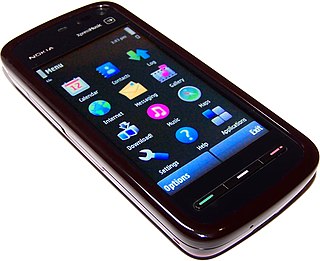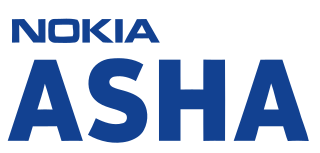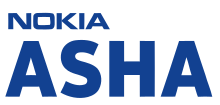Series 40, often shortened as S40, is a software platform and application user interface (UI) software on Nokia's broad range of mid-tier feature phones, as well as on some of the Vertu line of luxury phones. It was one of the world's most widely used mobile phone platforms and found in hundreds of millions of devices. Nokia announced on 25 January 2012 that the company has sold over 1.5 billion Series 40 devices. It was not used for smartphones, with Nokia turning first to Symbian, then in 2012–2017 to Windows Phone, and most recently Android. However, in 2012 and 2013, several Series 40 phones from the Asha line, such as the 308, 309 and 311, were advertised as "smartphones" although they do not actually support smartphone features like multitasking or a fully fledged HTML browser.
Wi-Fi calling refers to mobile phone voice calls and data that are made over IP networks using Wi-Fi, instead of the cell towers provided by cellular networks. Using this feature, compatible handsets are able to route regular cellular calls through a wireless LAN (Wi-Fi) network with broadband Internet, while seamlessly change connections between the two where necessary. This feature makes use of the Generic Access Network (GAN) protocol, also known as Unlicensed Mobile Access (UMA).

The Nokia Eseries consists of business-oriented smartphones running Symbian OS, with emphasis on enhanced connectivity and support for corporate e-mail push services, as well as enterprise-styled products and many featuring QWERTY keyboards. All devices have advanced office features through its S60 platform. Phones equipped with Wireless LAN also provide a VoIP client. Throughout the series' lifetime its main competitors were BlackBerry products from Research In Motion. The Eseries was marketed until 2011.
Mobile VoIP or simply mVoIP is an extension of mobility to a voice over IP network. Two types of communication are generally supported: cordless telephones using DECT or PCS protocols for short range or campus communications where all base stations are linked into the same LAN, and wider area communications using 3G or 4G protocols.

The Nokia N95 is a smartphone produced by Nokia as part of their Nseries line of portable devices. Announced in September 2006, it was released to the market in March 2007. The N95 ran S60 3rd Edition, on Symbian OS v9.2. It has a two-way sliding mechanism, which can be used to access either media playback buttons or a numeric keypad. It was first released in silver and later on in black, with limited edition quantities in gold and purple. The launch price of the N95 was around €550.

Nokia 5800 XpressMusic is a smartphone part of the XpressMusic line, announced by Nokia on 2 October 2008 in London and started shipping in November of that year. Code-named "Tube", it was the first touchscreen-equipped S60 device by Nokia – essentially it was the first device to run Symbian^1, also known as S60 5th Edition, the touch-specific S60-based platform created by the Symbian Foundation. The touchscreen features tactile feedback.

The Nokia 5230 is a smartphone manufactured by Nokia, running Symbian OS v9.4, S60 5th Edition. It was released in November 2009 after being announced in August of the same year.

The Nokia X3 Touch and Type also known as Nokia X3-02 is a mobile telephone handset produced by Nokia. This is the first mobile handset released by Nokia that possesses a touchscreen in a "candybar" phone form factor. It is also the first touchscreen handset from Nokia that runs the Series 40 operating system. Previously released touchscreen devices from Nokia have either not had a physical keyboard, or they have had a slide-out, full-QWERTY keyboard. It was introduced on 13 August 2010 as one of the most advanced Series 40 devices in terms of features and specifications.
Nokia's strategic nomenclature can be traced back in 2005 when the Nseries line was launched, offering devices with flagship specifications and premium hardware at various price points. These devices were considered the "bread and butter" of the company and were often positioned to showcase their latest technologies. Thanks to the newfound consumer and enterprise interest in smartphones at the time, the company introduced four additional collections to diversify their product portfolio and meet demands in most market segments. These new phone series were named Eseries, targeting small business and enterprise customers; Xseries, providing consumer-grade multimedia-focused devices; Cseries, which Nokia used to target both the low-end and mid-range market segments; and Tseries, for devices exclusive to the Chinese market.

The Nokia Asha 303 is a QWERTY messenger phone powered by Nokia's Series 40 operating system. It was announced at Nokia World 2011 in London along with three others Asha phones - the Nokia Asha 200, 201 and 300. The 303 is considered to be the flagship of the Asha family. Its main features are the QWERTY keyboard and capacitive touchscreen, the pentaband 3G radio, SIP VoIP over 3G and Wi-Fi and the ability to play Angry Birds which were all never seen before on a Series 40 phone. Nokia Asha 303 is available in a number of languages depending on which territory it is marketed for. Models sold in South Asia support at least eight languages: English, Hindi, Gujarati, Marathi, Tamil, Kannada, Telugu and Malayalam.

The Nokia Asha 302 is a QWERTY messenger feature phone powered by Nokia's Series 40 operating system. It was announced at Mobile World Congress 2012 in Barcelona along with other Asha phones - the Nokia Asha 202 and 203. The 302 is considered to be among the flagship of the Asha family. Its main features are the QWERTY keyboard, the pentaband 3G radio, SIP VoIP over 3G and Wi-Fi. Its design looks a lot like the older Nokia E6 with chrome slidings, giving it a somewhat premium look. A software update adds Mail for Exchange support.

The Nokia Asha series was a range of low-end feature phones and smartphones produced and marketed by Nokia. The name "Asha" came from the Hindi word meaning "hope".

The Nokia Asha 306 is a "Full Touch" phone powered by Nokia's Series 40 operating system. It was announced at Bangkok by Nokia along with two others Asha Full Touch phones - the Nokia Asha 305 and 311. The 306 is considered to be the little brother of Asha 311 as it lacks 3G and capacitive touch screen. Its main features are the Full Touch resistive touchscreen and WLAN.

The Nokia Asha 305 is a "Full Touch" phone powered by Nokia's Series 40 operating system. It was announced at Bangkok by Nokia along with two other Asha Full Touch phones - the Nokia Asha 306 and 311. Its main features are the Full Touch resistive touchscreen and dual SIM.
Nokia Asha 309 is a mid-range phone and the successor to the Nokia Asha 306. The phone was announced in 2012, September and is expected to be released in Q4, 2012. The phone features a capacitive touch screen and WLAN Wi-Fi over the dual-sim feature seen in Nokia Asha 308.

Nokia Asha 501 is a low-end smartphone from the Nokia Asha series, announced by Nokia on 9 May 2013 in India, and released on 24 June 2013. The device is classified by Nokia as a "Full Touch" smartphone. The phone is available in either single- or dual SIM configuration.

The Nokia Asha platform is a mobile operating system (OS) and computing platform designed for low-end borderline smartphones, based on software from Smarterphone which was acquired by Nokia. The platform inherits UI similarities mostly from MeeGo "Harmattan", and replaces Series 40 on Nokia's low-end devices. The user interface design team was headed by Peter Skillman, who had worked previously on webOS and the design of MeeGo for the Nokia N9.
Nokia Asha 500 is a low-end smartphone from the Nokia Asha series announced on 22 October 2013 by Nokia in Abu Dhabi. The device is built on the Nokia Asha software platform based on technology originally developed from Series 40 and Smarterphone.

The Nokia Asha 310, also known as the Nokia Asha 3010 or the Nokia ASHA 310 RM-911, was released in March 2013. It is the first in the line of the Asha range of phones to have dual subscriber identity module (SIM) slots and Wi-Fi connectivity. It was a reinvention of the Asha range to remain competitive with new Android devices. It cost $102.00 at its launch date. It has a touchscreen, comes with either a 2 or 4 GB micro SD card, and has 64 MB of RAM, a 2 MP camera and a battery that can last up to 600 hours in standby mode. The phone can play music for up to 54 hours or video for up to 9.5 hours, and has a maximum of 17 hours talk time (2G).









